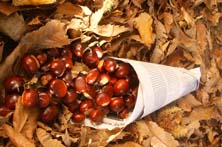All Saints' Day in Spain
O the first day of November it doesn't matter what city in Spain we go to: in each one this day is reserved for visiting cemeteries and remembering those that are no longer with us. The interesting thing about this event is that officially the actual day of the deceased falls on 2nd November according to Christian doctrine; but many years ago a lot of people agreed to make the most of the festival to take the time to go to the cemetery. Similarly, the harvesting of some fruits used to start on 1st November, and you'll find plenty of parties throughout the countryside.

A few times these parties pick chestnuts. So, for example, in large populations of Galicia, Cantabria, Catalonia, Aragon, Asturias, Andalusia or Castile and Leon "castanadas" or "magostos" take place in which these fruits are served roasted, or prepared in different ways, generally as sweets.
Chestnuts, walnuts and other dried fruits are also prominent on this day in Ceuta. "Backpack day" is celebrated there, where residents rush to spend a day on the hillside enjoying the fruits.
In Cadiz a single celebrate takes place on the eve of All Saints', or tosantos: since the nineteenth century the city markets are decorated, open days are organized for the different visitors and they even "dress up their products" in what we could call a completely commercial carnival.
Also commercial is the "All Saints' Festival" in Concentaina (Alicante), which has been celebrating it since 1346, making it the second oldest agricultural festival in Spain.

But All Saints' Day also makes room for art, especially theater. Until a very short time ago on this day it was a tradition to play Jose Zorrilla's Don Juan Tenorio. The theme and background were ideal: the rebellious sinner, among the dead, gets redemption twilight of his life. These days there's not some much interest in that work, but in some towns and cities we can still see it on that day.
It's interesting how the solemn, festive, informal and cultural can all be brought together in just one day.


